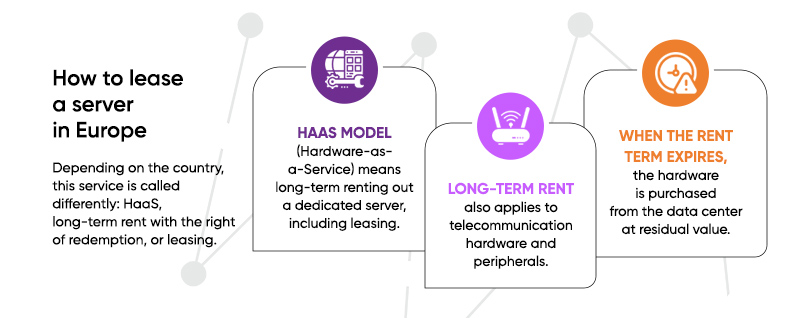Contents
In Europe, renting a dedicated server with the right of redemption for an average of three years with fixed or decreasing payments is a widespread practice. Depending on the country, this service is called differently: HaaS, long-term rent with the right of redemption, or leasing.
Consider that a local European or foreign company needs to have servers in Europe without transporting its own hardware across countries and continents. To solve the problem, take a long-term rent of servers from Dell, IBM, HP, Supermicro, Lenovo, Juniper, etc. with the right of redemption. This option applies not only to servers and data storage systems, but also to telecommunication hardware and peripherals.
Long-term rent with the right of redemption (leasing) in Europe is most often used in an operating scheme resembling a rent. A company rents IT hardware from a provider and uses it. When the rent term expires, the hardware is purchased from the data center at residual value or replaced with more advanced equipment (depending on the terms of the customer agreement).

Who requires HaaS
The lack of required amount of money, the need to save budget and the inability to pay for IT maintenance costs lead to the growing popularity of HaaS model (Hardware-as-a-Service). This model means long-term renting out a dedicated server, including leasing.
What is the difference between leasing and long-term renting out? Classic leasing is a procedure that involves a third party providing borrowing funds, which are used to purchase IT hardware that the client brings to the data center. When it comes to a long-term rent with the right of redemption or cooperation in HaaS, the client enters into a contract directly with the provider who rents out the hardware. It is more profitable to sign the contract directly with the service provider, excluding intermediaries. The client purchases hardware in installments: pays the rental charges and the rented hardware becomes the client’s property, when the agreement expires.
Server rental services with the right of redemption are offered by providers who purchase equipment for the client, bypassing various intermediaries. This model allows even complex projects to be realized on a turnkey basis, taking into account all the client’s wishes.
In this case, it is not necessary to freeze a significant amount of corporate funds. Such a scheme is important for preserving operating assets, optimizing taxation, and upgrading IT infrastructure without capital costs. In addition, the company saves on VAT from 14 to 30% of the budget (depending on the tax rates of the country where the server is located), including reduction of income tax. In this case rental (leasing) payments act as the company expenses, which leads to tax reduction.
In HaaS rent payment for hardware is paid monthly, reducing the company’s cost loading. High SLA incentives, hardware fault tolerance, and cost savings are guaranteed.

The costs of telecommunications equipment and IT infrastructure are quite serious, requiring large investments for the company to keep a competitive edge. If there is no money available, turning to an equipment rental company and purchasing server space in HaaS (leasing) help to solve the issue of purchasing of hardware.
Renting hardware via HaaS is most often demanded by banks, financial organizations, retail, governmental clients, large international companies, oil & gas and energy companies, gambling companies, etc.
Typical HaaS use cases
The most typical HaaS use cases can be conditionally divided into five blocks:
- Developers require having a test environment when they need to test a hypothesis, but do not have a physical server on hand. There may not be enough budget to purchase a required hardware or there is no certainty that the purchased hardware will be needed after one or two years of its service.
- When running high-load applications, including heavy DBMSs, artificial intelligence systems, and GPU computing, there is a need for new capacities and volumes. Suppose you need to create a highly loaded cluster with a huge virtual disk in a cloud infrastructure with 1.5TB of RAM and 70-80 cores. This is costly, but there is another solution: rent one or two dedicated servers. In this situation your choice depends on many circumstances, as well as what solution is more convenient for the company and what hardware is more familiar to your technical team.
- When working with large databases, it is not recommended to use cloud and virtual environments, as there is a high risk that they will start to conflict with each other. DBMSs are more stable, but they also run a few percent faster during tests on bare hardware. The increase is not critical, but each company decides for itself which option is preferable.
- There are situations when high requirements are issued for hard disk performance. For example, you need guaranteed I/O performance of at least 60-70 thousand IOPS. HaaS allows you to work with NVMe disks in different RAIDs, providing reliable network connectivity and eliminating virtualization, which affects the performance of the disk subsystem. This is extremely relevant in a number of scenarios.
- The work involves compute intensive operations and the servers are not fully utilized. If it is obvious where and how over 90% of the server resources are spent, it is logical to switch to HaaS.
Advantages of hardware leasing (long-term renting with the right of redemption)
The hardware is covered by extended warranty service from the vendor and post-warranty maintenance from the service provider with free replacement of components. This means that while the server is under extended warranty, any replacement hardware is taken from the manufacturer’s warehouses as soon as possible.

Depending on the customer's requirements for the maintenance of their equipment, it is possible to choose different terms and conditions in service contracts. For example, Next Business Day (NBD), which guarantees delivery of new components to replace failed ones in any European country on the next working day during working hours. If it is necessary to reduce downtime due to equipment breakdowns, it is worth choosing to provide services 24 hours a day, 7 days a week and replace broken components within 8 hours. This applies to all components, so it doesn't matter whether a small circuit board or an 80-kilogram battery has failed.
With post-warranty service, the provider assumes almost the same functions as the vendor did previously. In this case, the client pays unburdened monthly insurance (about €30) for hardware maintenance which guarantees that in case of failure of components (regardless of cost); the provider will find, buy and replace them independently, without taking a single euro from the client. For the server owner it is advantageous, because in case of failure of any node – hard disk, system block (regardless of its cost) – its purchase and replacement entirely falls on the service provider.
Another great advantage of hardware leasing is that it offers to even low-budget companies the opportunity to use powerful hardware without actually owning it. For 3-4 years the leased server becomes an unconditional asset of the lessee. This is beneficial especially in cases when the company considered the option of purchasing a low-end server, minimizing the required amount of resources in order to fit into the budget.
Using a long-term renting with a right of redemption (leasing) service, a company can purchase more high-end hardware that meets its business objectives without incurring high costs. In fact, the possibility of spreading the financial burden over 36 months, nothing changes for the company’s budget. It can either invest in a low-end server for €20,000 or buy high-end hardware for €30,000 in installments.
The advantage is that you do not have to pay large sums of money immediately. It is enough to pay 2-3% of the real cost of the hardware (at a server’s cost of €20,000, the first payment is just €400!), with subsequent switch to on-site maintenance service from the provider. While the server is in leasing (long-term rent with the right of redemption), its capacity can be resold by subleasing it and earning money that can be used for monthly payments.
Payment is most often based on a fixed payment model, where the loan principle is repaid immediately rather than accruing interest. In this case, the price of the server is fixed at the time of the contract, although in three years similar new equipment will become more expensive. Unlike credit, leasing (long-term rent with the right of redemption, HaaS) means payment in equal installments, without credit rates and overpayments.
Reducing company’s monthly expenses to 63.4% with HaaS: an illustrative example
To explain how this service can help the client, let’s consider a typical situation of renting a server with an option to buy it out, which is often the reason for contacting a provider. The rental agreement is signed, for example, for three years. The cost of the hardware is broken down over this period, and at the expiration of the agreement the client can buy out the server at its residual value.
To find out the cost of renting a server with buyout, let’s look at a simple financial calculation. A customer wants a server (7x HPE Servers, 1x Storage Dell EMC Unity 300, 2x Juniper SRX 1500, 1x Cisco ASA 5512-X) for which the total payment is €333,623.8. This amount of money is not available at the time but it is possible to rent the server with a buyout. For this purpose, a rental agreement is signed for a period of 36 months. The one-time payment is €8,900 and the monthly payment is €8,893.06. The cost already includes all the services of the provider: hosting, connection, and maintenance.After the service agreement has expired, a sale and purchase agreement is executed for the amount of residual redemption of €4573.8 and two agreements are signed. The first agreement specifies the rental of the rack, Internet and IPv4 in the amount of €1,550 per month and the second one deals with the maintenance of the equipment in the amount of €1,705 per month. This way, after three years, the client gets a reduction in the monthly payment from €8,893.06 to €3,255, which means 63.4% reduction in the company’s costs each month, and he already owns his own server and only pays for the hosting and maintenance of the hardware.
After redemption of the hardware, the payment for the dedicated server services is no longer charged, only service agreements for colocation and technical support for full maintenance remain to be paid. At the same time, the servers remain fully client-side managed at the physical hardware level. You can install your own virtualization systems, combine servers, and connect them to data storage systems and network equipment.
The provider, acting as hardware rental (leasing) company, takes full responsibility for security and access to the hardware. So, when renting server space in HaaS, the burden on the customer of services is reduced because all the work on procurement, equipment placement and administration is performed by the service provider. In the long term, this reduces the cost of owning your own IT infrastructure.
How to lease a server with HaaS model: long-term rent in Europe
Write us a message to get additional information.
or book a free consultation
After analyzing 20 service providers in Europe that provide hardware for long-term rent with the right of redemption (leasing/HaaS), we prepared a guide on how best to choose your lessor and get the maximum benefits from leasing a server hardware to achieve significant reduction in IT infrastructure maintenance costs.

Article author
Olga Boujanova
Consultant on server hardware, network and cloud technologies
